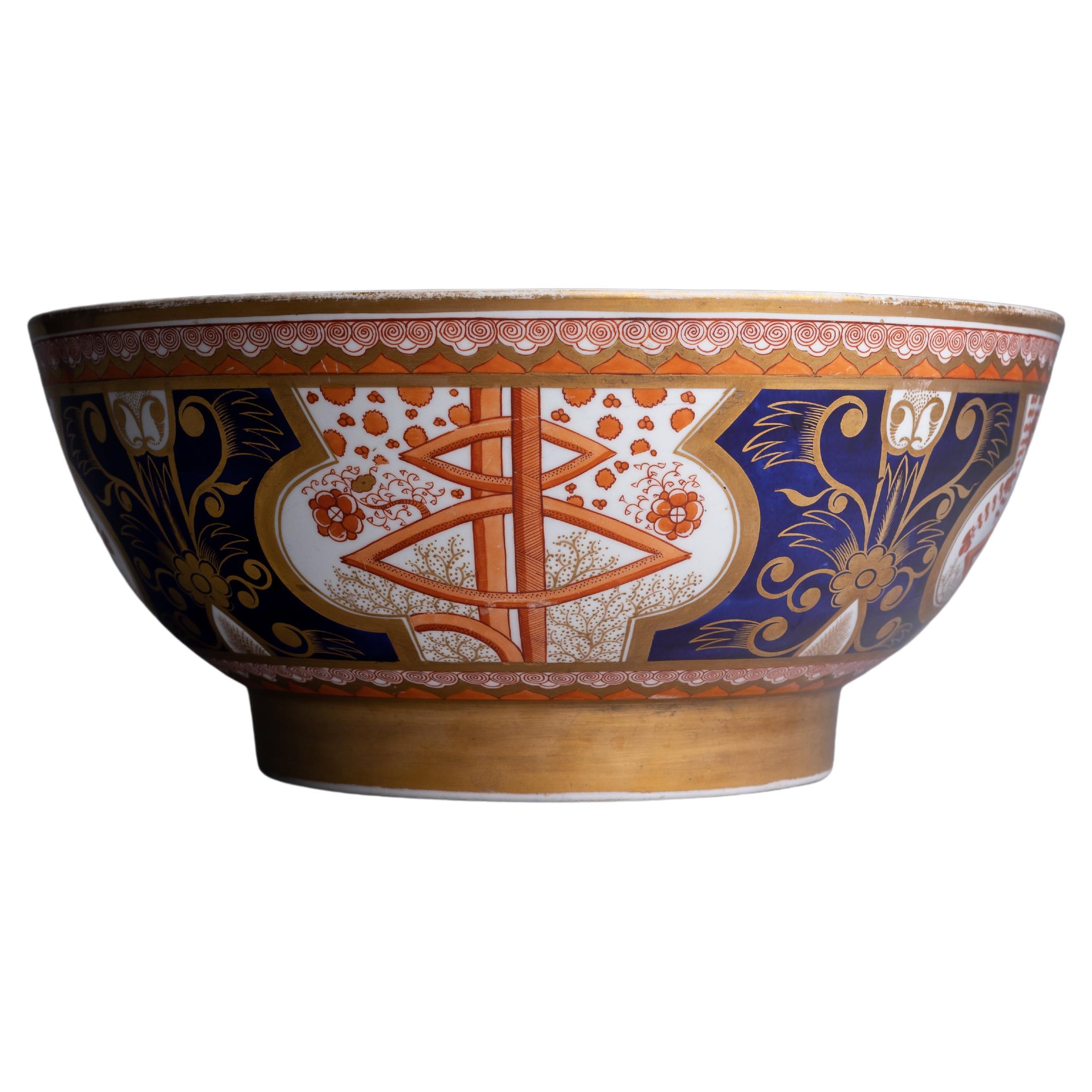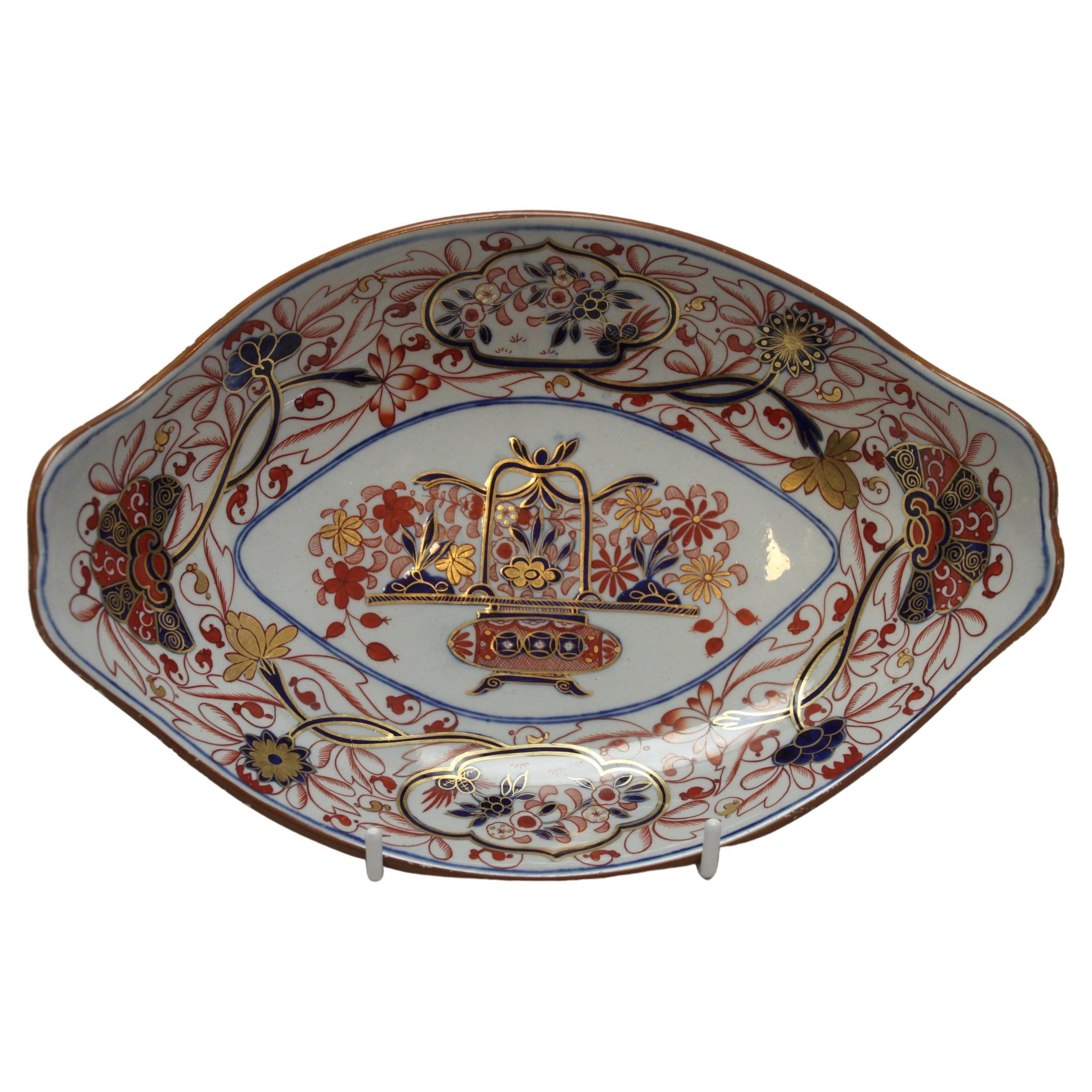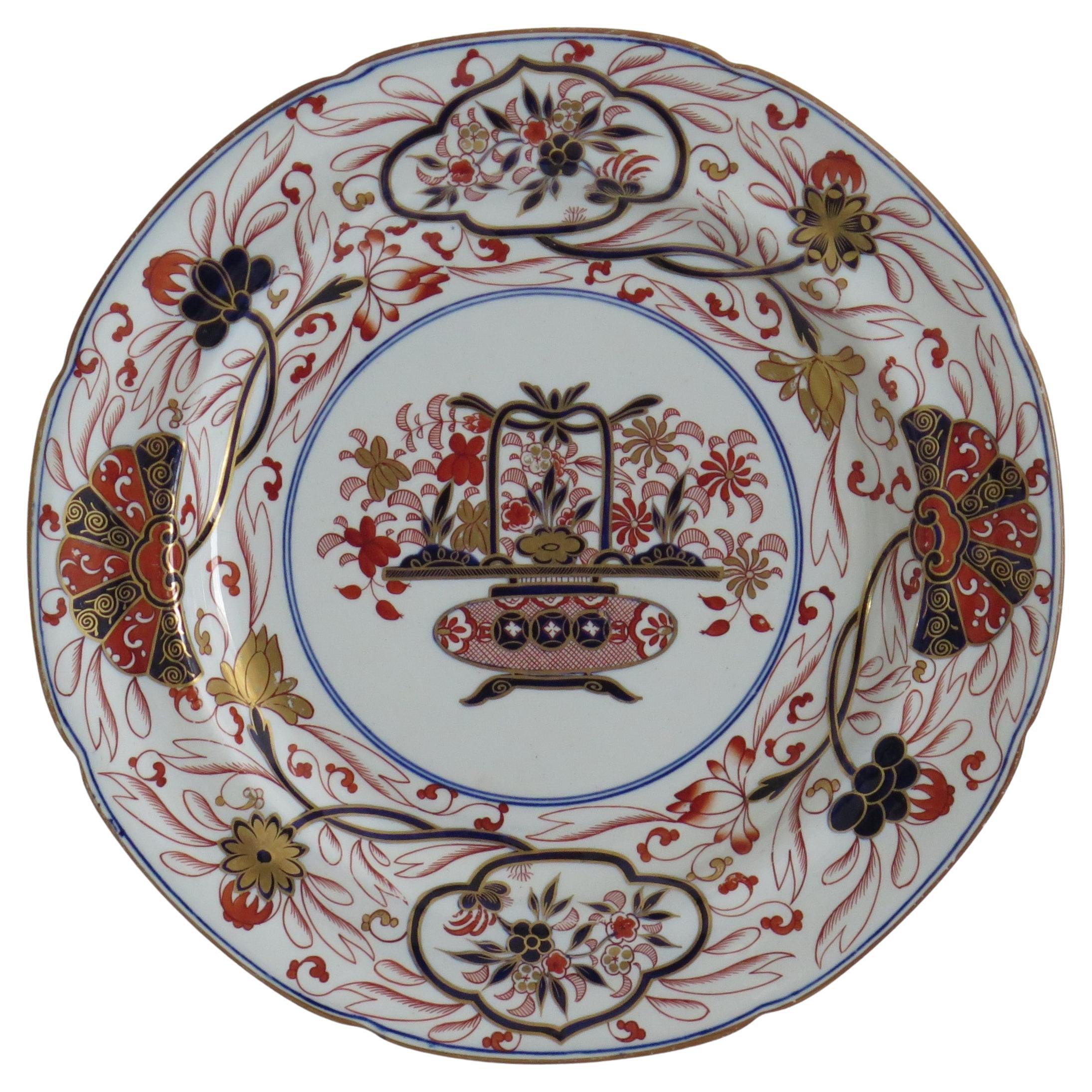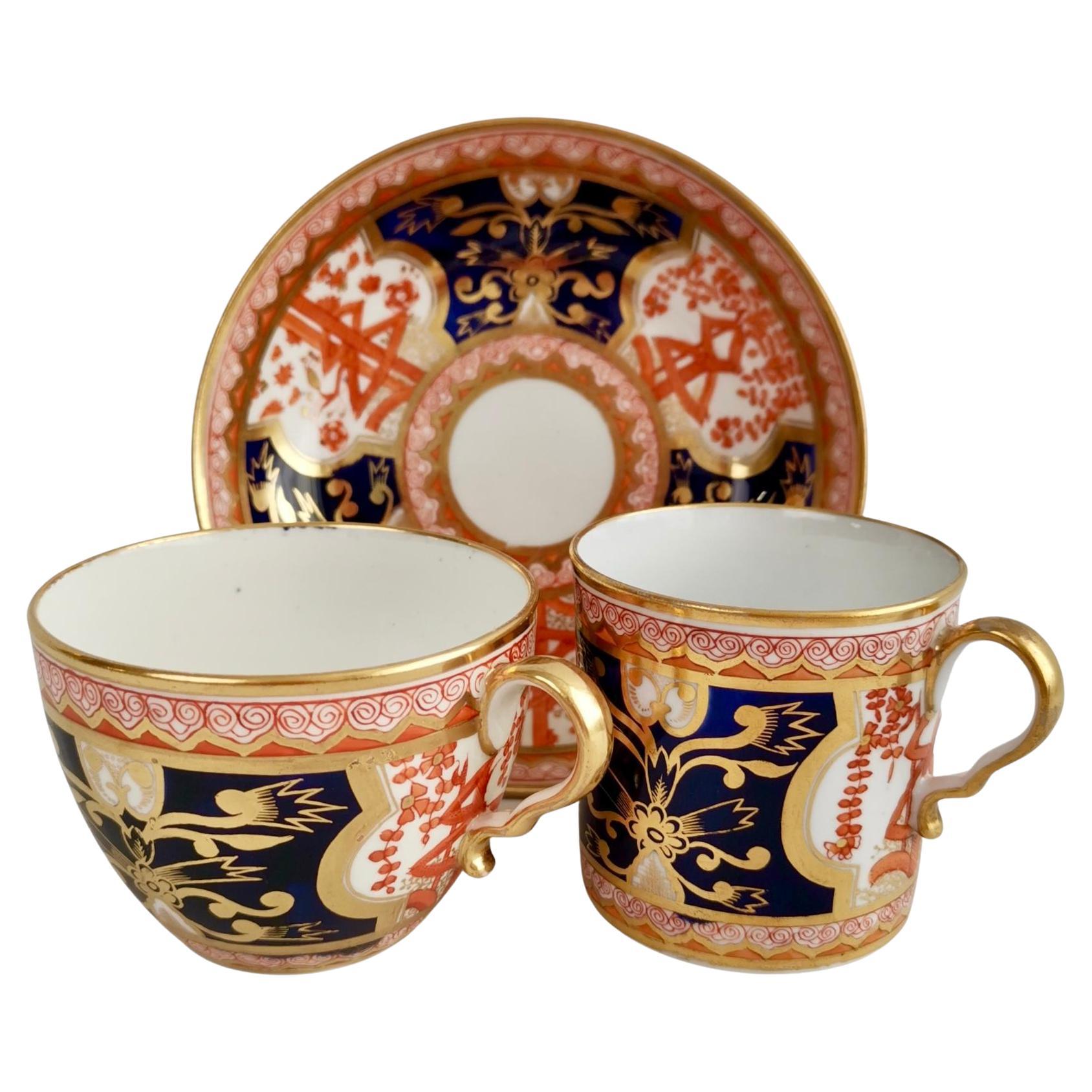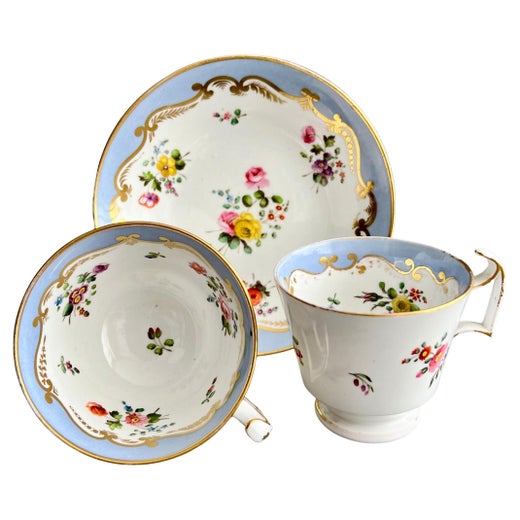Regency Spode Imari Punch Bowl, Pattern # 2283
About the Item
Spode
Spode is one of the oldest and most distinguished of the great pottery companies of Staffordshire, the time-honored home of English ceramics. The firm’s blue and white bone china transferware is a timeless classic. Spode dishes compose the sort of elegant dinner service that most of us envision on a traditional holiday table.
The company was established in 1770 in Stoke-on-Trent by Josiah Spode, a friend and neighbor of another estimable English ceramist, Josiah Wedgwood. The Wedgwood firm first came to prominence for its tableware, which quickly gained favor in aristocratic households throughout Britain and Europe.
Spode was particularly known for two technical achievements in the firm’s early decades. The first was to develop a standard formula for the making of bone china — a type of porcelain (made with a mixture of bone ash, minerals and clay) that is dazzlingly white and so strong it can be used to create very thin translucent plates and vessels.
The other advancement was to perfect the making of transferware. That process involves the transfer of pictorial images inked on tissue paper — such as the garden scenery in the famous Willow dish patterns — onto ceramics that are then sealed with a glaze.
From the 1820s onward, Spode enjoyed tremendous success both in Britain and elsewhere owing to the beauty and vitality of its decorative imagery. By some counts, Spode created more than 40,000 patterns in the 19th century.
In 1833, following the sudden death of Josiah Spode III, business partner W. T. Copeland took over the company and changed its name to Copeland Spode (it later changed again, this time to W. T. Copeland and Sons). Collectors regard Copeland-marked pieces as Spode china. The Spode brand was revived in 1970.
Many favorite Spode patterns — among them Blue Italian, Indian Tree, Greek and Woodland — date to the company’s early years. Spode’s most popular pattern, Christmas Tree, was introduced in 1938.
Prices for antique and vintage Spode china vary widely, based on the size of the service, its condition and the pattern. An antique dinner service for 12 people or more, in good repair and complete with cups and serving dishes, will generally cost between $10,000 and $20,000. Such Spode services become heirlooms — a proud and timeless addition to a family’s table. And as you will see on these pages, Spode’s rich and varied wares offer a visual feast in and of themselves.
Find Spode serveware, ceramics and decorative objects on 1stDibs.
- ShippingRetrieving quote...Ships From: Downingtown, PA
- Return PolicyA return for this item may be initiated within 3 days of delivery.
- Regency Spode Neo-Classical Greek Pattern Blue TazzaBy SpodeLocated in Downingtown, PASpode Neo-Classical Greek Pattern Tazza Early-19th century The Spode pottery underglaze blue Greek pattern has an oval shaped top with a central des...Category
Antique Early 19th Century English Regency Pottery
MaterialsPearlware, Pottery
- Regency Spode Pottery Neo-Classical Greek Pattern Blue DishBy SpodeLocated in Downingtown, PARegency Spode Pottery Neo-Classical Greek Pattern Blue Dish, Bellerophon's Victory Over Chimera, Early-19th century The Spode Greek pattern pottery, sh...Category
Antique Early 19th Century English Neoclassical Pottery
MaterialsPearlware, Pottery
- Regency Spode Porcelain Botanical Specimen DishBy SpodeLocated in Downingtown, PASpode Porcelain Botanical Specimen Dish, Bulbocodium vernum, commonly called Spring Meadow Saffron, After William Curtis Circa 1810-20 The botanical is after William Curtis's The B...Category
Antique Early 19th Century English Regency Platters and Serveware
MaterialsPorcelain
- Piero Fornasetti Ceramic Set Neo-Classical Mythological Gold Coasters MitologiaBy Piero FornasettiLocated in Downingtown, PAPiero Fornasetti ceramic complete set of neo-classical gold coasters, Mitologia Pattern, Mythology Pattern, 1950s Measures: Diameter 4 1/8 inches x...Category
Mid-20th Century Mid-Century Modern Barware
MaterialsCeramic
- Spode Neo-classical Greek Pattern Blue Rectangular Dessert DishesBy SpodeLocated in Downingtown, PASpode neo-Classical Greek pattern blue rectangular dessert dishes, Four figures in battle, Early 19th century The Spode Greek pattern pottery ...Category
Antique Early 18th Century English Neoclassical Pottery
MaterialsPearlware, Pottery
- Spode Pottery Neo-Classical Greek Pattern Blue Deep DishBy SpodeLocated in Downingtown, PASpode pottery neo-classical Greek pattern blue deep dish, Bacchus Mounted on a Panther, Early-19th Century The Spode Greek pattern pottery shaped rectangular dish with cantered...Category
Antique Early 19th Century English Neoclassical Pottery
MaterialsPearlware, Pottery
- Early Spode Regency Dollar Pattern Punch BowlBy SpodeLocated in Fort Lauderdale, FLA large Spode Regency porcelain punch bowl in the Dollar pattern, made in England circa 1810. This punch bowl, designed by English potters after Asian motifs and named for an American currency, presents a fascinating instance of globalization in the ceramic medium. The Spode Dollar pattern...Category
Antique 1810s English Regency Serving Bowls
MaterialsCeramic, Porcelain
- Spode Stone China Dish Decorated with Pattern 2283By SpodeLocated in East Geelong, VICThis oval hand coloured and gilded Spode Stone China dish is decorated with an Imari pattern- pattern 2283. It could also be that this item is a stan...Category
Antique 1810s English Regency Platters and Serveware
MaterialsStoneware
- Georgian Spode Dinner Plate a Ironstone Chinoiserie Pattern No.2283, circa 1820By Josiah SpodeLocated in Lincoln, LincolnshireThis is a very beautiful hand painted dinner plate, produced by the Spode factory in the late Georgian period, Circa 1820. This is pattern number 2283, the chinoiserie decoration ...Category
Antique Early 19th Century English Chinoiserie Ceramics
MaterialsIronstone
- Georgian Spode Dinner Plate B Ironstone Chinoiserie Pattern No.2283, circa 1820By Josiah SpodeLocated in Lincoln, LincolnshireThis is a very beautiful hand painted dinner plate, produced by the Spode factory in the late Georgian period, Circa 1820. This is pattern number 2283, the chinoiserie decoration ...Category
Antique Early 19th Century English Chinoiserie Ceramics
MaterialsIronstone
- Georgian Spode Soup Bowl or Deep Plate in Chinese Flowers Pattern, circa 1820By SpodeLocated in Lincoln, LincolnshireThis is a beautiful bowl or deep plate produced by the Spode factory and made of a type of a pottery called Pearl-ware, in the early 19th Century. The pattern is called "Chinese Flo...Category
Antique Early 19th Century English Chinoiserie Decorative Bowls
MaterialsPearlware
- Spode Porcelain Teacup Trio, Red Imari Dollar Pattern, Regency, ca 1810By SpodeLocated in London, GBThis is a beautiful orphaned teacup made by Spode in about 1810. It bears a beautiful Japanese-inspired Imari pattern. Spode was the great pioneer among the Georgian potters in England. Around the year 1800 he perfected the bone china recipe that has been used by British potters ever since, and he was also the leading potter behind the technique of transferware, making it possible for English potters to replace the Chinese export china, which had come to an end around that time, with their own designs. This was fundamental to a thriving industry that would last for about 150 years and provide half the world with their tableware. Spode porcelain is regarded as one of the highest quality porcelains around; for a soft-paste porcelain it is surprisingly hard and fine, and has a wonderful bright white colour. The pattern on this can is called "Dollar" pattern, a very famous pattern that was used by English potters in the 18th and early 19th Century. It is obvious why it is called “dollar” - but its origin is less obvious! It is thought that this pattern was derived from a very old Chinese pattern depicting a tree with elaborate foliage that hides a Chinese character representing longevity or happiness. Traditionally, this went with a an image called “Taotie”, which was used on very ancient bronze vases...Category
Antique Early 1800s English Regency Porcelain
MaterialsPorcelain
